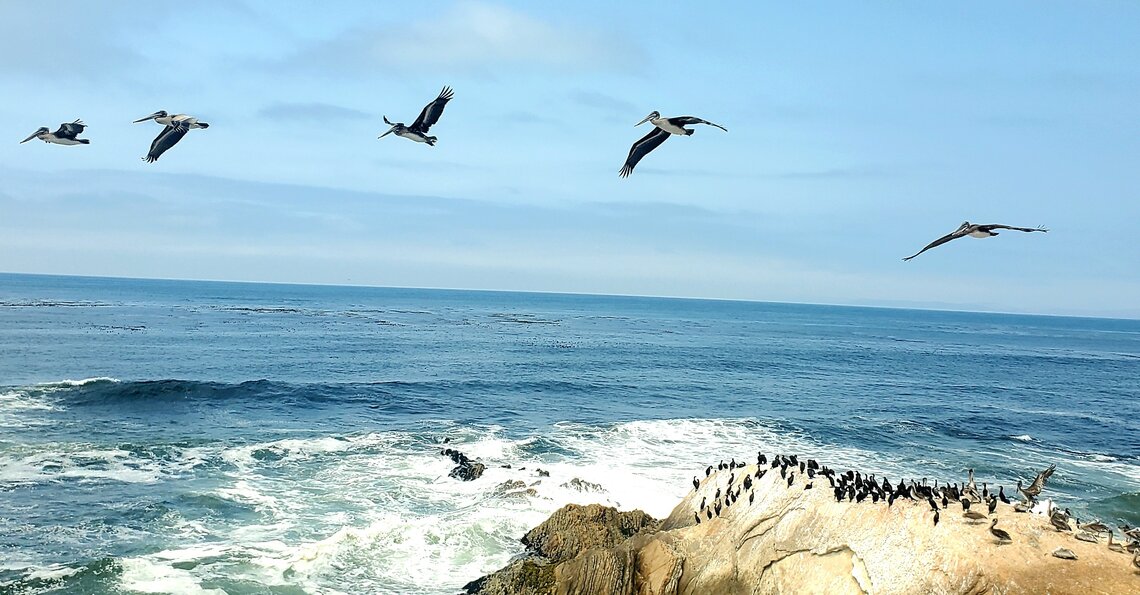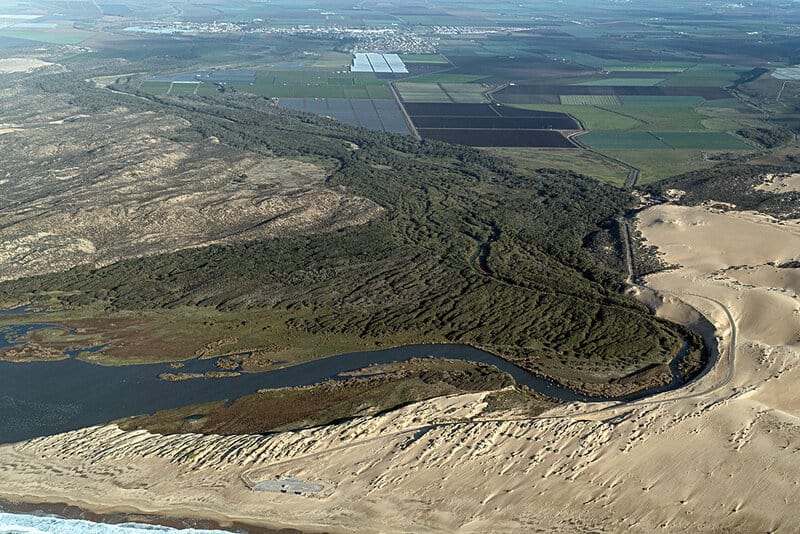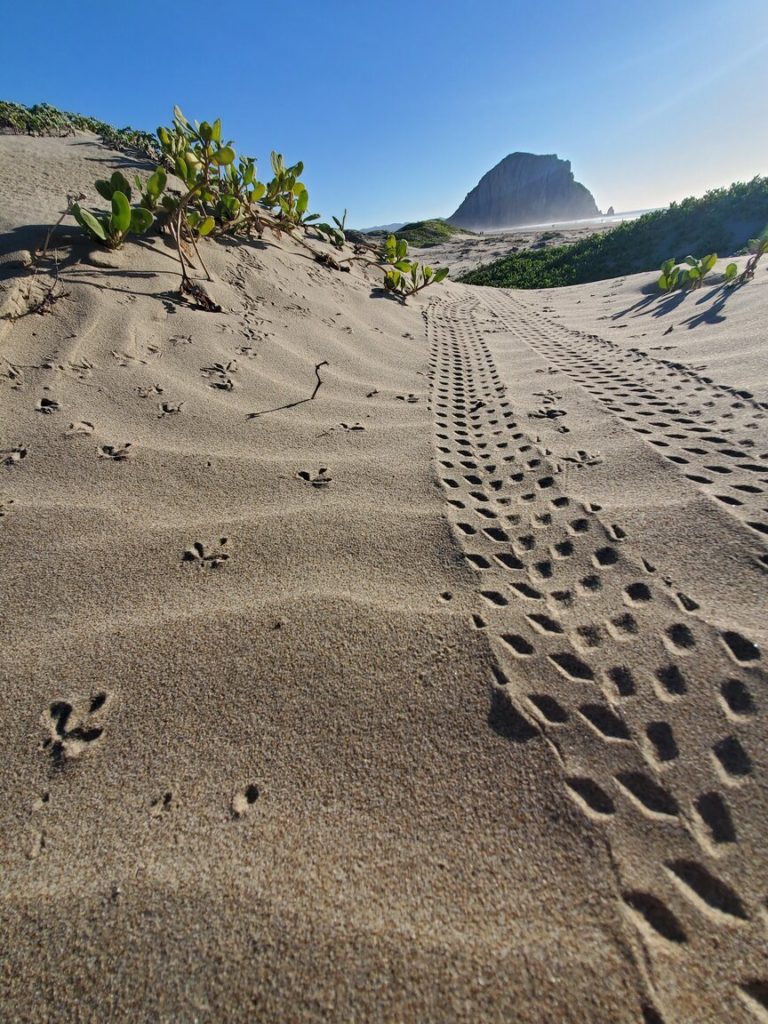
California Brown Pelicans coasting along the rocky bluffs of Montaño de Oro State Park, San Luis Obispo County, California (photo by Connor Jandreau).
By Connor Jandreau, California Central Coast Joint Venture Coordinator
For many years now, the Sonoran Joint Venture has been instrumental in supporting efforts to fill the remaining gap in United States Joint Venture coverage as a sure way to strengthen conservation outcomes north of the SJV region and across the Pacific Flyway. This gap, also known as California’s Central Coast, boasts superlative ecological diversity, ranging from the southern-most extent of redwoods (Sequoia sempervirens), the state’s largest intact stands of coastal oak woodlands, to a collection of some of earth’s rarest and most endangered Mediterranean dune ecosystems. The rich complexion of soil regimes, geophysical variation, climatic factors and millennia of human land uses have resulted in this rich complexion of habitats that today supports more than 1.5 million people.

Estuary and rare coastal sand dunes of the Santa Maria River, Santa Barbara County, California, with intensive, row-crop agriculture in the background (photo by Jim Dougherty).
In 2020, under unanimous support from over thirty participating agencies and organizations, the inaugural California Central Coast Joint Venture (C3JV) Management Board was established along with the approval of bylaws and, later that year, hiring of a full-time coordinator to propel the emerging partnership. This launch was a feat of commitment by partners, and advanced by the support of neighboring Joint Ventures, including the San Francisco Bay Joint Venture, the Central Valley Joint Venture and the Sonoran Joint Venture.
The region includes portions of what are known today as San Mateo, San Benito, Santa Clara, Santa Cruz, Monterey, San Luis Obispo, Santa Barbara, Ventura and Kern Counties– the sacred homelands of Indigenous Muwekma Ohlone, Awaswas, Popeloutchom (Amah Mutsun), Rumsen, Salinan, Esselen, Chumash and Yukot Peoples. As a voluntary, cooperative, regional partnership composed of federal, tribal, and state entities working with nonprofit organizations, private industry, land stewards, and academia, the C3JV aims to further a vision of the Central Coast as a thriving community where our lands and waters are shared among birds, other wildlife and people in a relationship of mutual wellbeing.

Rekindling connections to place, and our relationships with environment, plays an important theme in the C3JV’s conservation efforts. Western Snowy Plover and e-bike tracks framed by Morro Rock, San Luis Obispo County, California (photo by Connor Jandreau).
The C3JV is in the midst of building a strategic plan to orient and guide the partnership towards coordinated, strategic, and inclusive, conservation actions. As part of this planning process, the C3JV has identified seven conservation targets, composed of important habitat complexes, and three human wellbeing goals, representing essential tenants to rekindling human-land-sea relationships. Our conservation targets employ focal bird species as indicators of ecosystem health and conservation progress. In rejecting the notion that humans are disjunct, separate or above nature, an integration of conservation and wellbeing is not only a more just approach, but perhaps also the only way in which we can successfully meet the monumental socio-ecological challenges facing our moment in history.
The C3JV geography is a quilt of jurisdictions, landforms, histories and cultures. Perhaps in reflecting this complexion, the C3JV geography is also an amalgamation of Joint Venture regions, with overlapping alliances between neighboring JVs in an effort to strengthen the representation within these socio-ecologically important regions. For example, the C3JV is allied with the Sonoran Joint Venture within the Point Conception and northern Santa Barbara/Ventura County region. This alliance space within the homelands of the Chumash, marks an important transition zone with the Transverse Range demarcating an ecological shift terrestrially, and the Southern California Bight mirroring this transition in the California Current System. This region also includes important waterways such as the Santa Ynez River, one of the most northerly strongholds for the Endangered Least Bell’s Vireo, as well as the Santa Maria River Valley, an incredibly rich floodplain with significant conservation and human wellbeing needs. By working together within these spaces of overlap and across the Pacific Flyway as a whole, our respective Joint Ventures reinforce the notion of cross-boundary collaboration as one of the most important factors advancing migratory bird conservation.
For more information and to connect with the efforts of the C3JV, please visit www.c3jv.org or reach out directly to Connor Jandreau, California Central Coast Joint Venture Coordinator.


 English
English  Español
Español